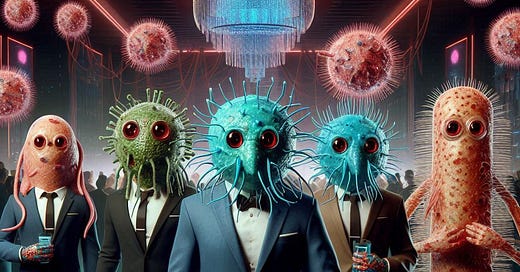First and foremost: Unadulterated milk is going to be riskier to consume than milk that has been pasteurized and homogenized. All sorts of miscreant micro-organisms are capable of living in raw milk that would love nothing more than to get into your belly and setup a sick rave. Picture this: A long limo of ice cold milk drives past belly button roundabout and drops off a nefarious crew in front of the exclusive Club Du Intestines. Several leggy pathogens and handsome bacteria slither out and up to the door where the front man checks the list under “Tummy Terrors”: Campylobacter, Cryptosporidium, E. coli, Listeria, Brucella, and Salmonella.
“Oh! Well PLEASE come right in!” he says as they ooze past, leaving a trail of pestilance on the ground. One does not delay the entry of such infamous nasties, each capable of bringing Bad Bad Leroy Brown down to his knees.
Campylobacter is a diarrheal bacteria that was discovered in the late 1800s, and it wasn’t until 1963 that it was named and documented. While having Campy’ dance around in your guts would most definitely be unpleasant, it usually does not require antibiotics to get rid of it, just keep yourself hydrated and within several days you will be rid of its unwelcome presence. What I found interesting was that it was commonly found on machinery used for mechanically separating chicken meat from the bone, otherwise known as highly processed chicken-based meat paste.
Cryptosporidium is another diarrheal causing disease, this time a parasite. It also tends to party hardy in the intestines, but unlike Campy’s relatively short existence of several days Crypto can party way longer, in the region of several weeks in the host. Despite the fact that it causes one’s digestive track to act like a New York city sewer for several weeks, the CDC reported that out of almost 450 outbreaks and 7500 cases between 2009-2017 there was only one death, and more than half the cases originated within recreational water parks and features. I would be remiss to mention that of the 450 outbreaks, 22 were food borne and 9 of those were associated with unpasteurized milk, but not the single death.
E. Coli is next on the list, and I don’t think he is as much of a club enthusiast, but more a tourist visiting the E. Coli ancestral home land. Our bodies have E. Coli in our lower intestines naturally, but when one of the few strains that are unfriendly to our guts gets into our system it does tend to leave things in worse shape than when it showed up, much like my weird uncle-in-law. Around two weeks of sickness that involves bloody diarrhea and stomach cramping is what the vast majority of people will present with, and they will recover without the need for medication. Less than 1% of victims die from their run-in with E.Coli, unless it worsens to where the kidneys get hit hard and the disease progresses to hemolytic uremic syndrome (HUS), of which a 3-5% mortality is seen.
The next guest being let in past the long line of microbic party-goers is going to be Listeria. The variety that tends to bother humans is fortunately low in its capacity for infection, which is a blessing because it survives wonderfully in temperatures between 38f and 98f with no problem. It is also the first disease in this post that doesn’t seem to mostly cause diarrhea and then leave you feeling a little lighter, if not worse for wear. This one is worse by far. The bug starts off in in the intestines with everyone else at the club, but then it is that one guy that wanders off from the party and gets into trouble elsewhere. “That’s Listeria” chuckle some of the others, “squirming through intestinal lining again”. Gross.
If the disease spreads beyond the abdominal tract then the symptoms can present as meningitis and/or sepsis, which assist in creating a mortality rate of 20-30% when Listeria is contracted. While the disease can be worrying for the immune compromised and young children, it is especially concerning for pregnant women because it can also infect the unborn baby. It is also not unique to dairy but rather is prevalent across the food pyramid; fruits, soil, meat, dairy products, and veggies are all common carriers.
Bruce might sound like one of the chill dudes trying to get into the club, but in reality he is a psychopath in a poncho. Brucella is one of the more deadly diseases listed on this post, and one of the ones I would be most concerned about if it hadn’t been essentially eradicated from bovine herds within the USA, except for three cases in 2024. I don’t really blame the US government for knocking this one down through concerted herd reduction and vaccine introduction because of how nasty of a disease it is for cattle. The symptoms in humans range from abdominal discomfort in 70% of cases, 20-60% have skeletal complications that range from arthritis to lumbar degradation via vertebral erosion. Neurological complications can also arise in the guise of everything from meningitis to intracerebral abscesses...yep, brain holes. Cardiovascular and pulmonary complications can also arise from contracting Brucellosis, but they are more rare and appear to be the killer in the form of Endocarditis.
Last one to enter the party hall is Sal, who has a really unique trick of being able to survive in environmental conditions where oxygen doesn’t exist, kind of like that cool kid at the community pool who could hold his breath longer than anyone else. Another interesting fact about Salmonella is that it can also cause typhoid fever, which causes your blood to run dirty and turns your body into a septic tank. Thankfully(?) the kind of Salmonella most commonly seen at parties is similar to the rest of his comrades, causing abdominal pains and diarrhea. It is also transferred by fecal matter and unsanitary conditions, which by now shouldn’t be a real surprise to anyone who has made it this far.
Aside from the six bad actors above, there are thousands of beneficial lifeforms in real milk that are not there to bring down the party, but rather improve certain aspects and deliver healthy resources. Below is shown what small farm, open air, well fed and happy cow-produced unadulterated milk has in it versus what processed milk that comes from a filthy, concrete enclosed, on average 500+ head of cattle, minimum effort input with maximum profits output concentrated animal feed operation looks like:
With that detailed breakdown of the who’s-who at your abdominal rave and the abve image showing the benefits of the elixir of life that is raw milk, I believe the unspoken worry over unadulterated dairy isn’t about “will this get me sick” but rather “should people be allowed the freedom to choose what they put in their bodies, even if it has a risk to make them sick?” Any one of the above mentioned party-goers can find their way into your unadulterated milk and it is a very real risk that at some point you can contract one of the diseases and have to face the bass; however, it is also a very real risk that a bag of lettuce, ground beef, chicken nuggets, or a dirty counter top can deliver the same rave as what is found in the raw.
There are guaranteed ways to give yourself a better chance at not contracting any diseases, and that is to visit the farm you are buying from. My wife and I encourage visits for exactly this reason, and because we believe in showing people the way in which we operate our small piece of nirvana. We drink our milk and very carefully observe sanitary procedures, which in turn should give our herdshare customers peace of mind because we wouldn’t drink something we are questionable about ourselves. Our small scale allows us to pay attention to every cow and what is needed to make sure everything is in our favor in terms of what we consume.
I am not a professional nutritionist, doctor, farmer, scientist, or magician; however, that hasn’t stopped me from reading up on zoonotic diseases, health benefits, regenerative agriculture, where does the coin go when placed behind the ear, and other pertinent questions to the many wonders of life. We have more information at our fingertips than at any other time, and yet all that information is for naught if it is only viewed through the lens of being the one who is “right” about whatever the topic is. Do the research and reach your own conclusions, choose small farms over ease of access to low effort products, and rarely assume that just because someone on a screen says one thing or another that it is correct in its entirety.
P.S. Bovine Tuberculosis is a boogie man that is often mentioned when someone wants to talk about raw milk and the risks it poses. I have already written specifically about it and Johnes here and you can keep researching and making up your own mind.








Thank you for this exposé. I hear that there are dangers, which I have been willing to risk, but having them outlined in detail is a great service... God bless.
AMAZING info I will pass along to others for sure. Thank you so much. We are drinking RAW milk exclusively making our own butter and yogurt from it and cheese. It is so easy as Raw milk naturally makes these things depending on where it is stored and how it is treated (like with probiotics, set on counter in warmth, covered and made in instapot (Yogurt) and never spoils! Thank you "Last Bastion Homestead for introducing us to liquid gold for our health, SHARON AND ROBYN